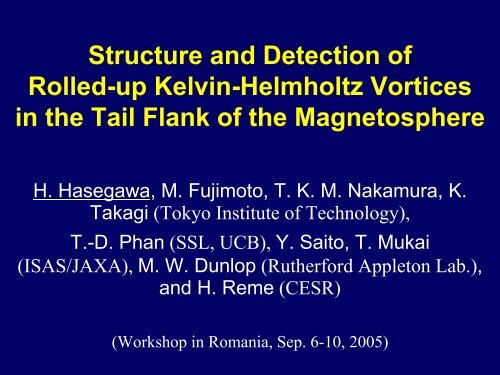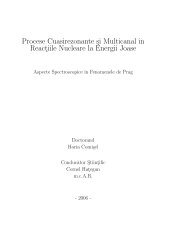Structure and detection of Kelvin-Helmholtz vortices in the ... - GPSM
Structure and detection of Kelvin-Helmholtz vortices in the ... - GPSM
Structure and detection of Kelvin-Helmholtz vortices in the ... - GPSM
Create successful ePaper yourself
Turn your PDF publications into a flip-book with our unique Google optimized e-Paper software.
<strong>Structure</strong> <strong>and</strong> Detection <strong>of</strong><br />
Rolled-up <strong>Kelv<strong>in</strong></strong>-<strong>Helmholtz</strong> Vortices<br />
<strong>in</strong> <strong>the</strong> Tail Flank <strong>of</strong> <strong>the</strong> Magnetosphere<br />
H. Hasegawa, M. Fujimoto, T. K. M. Nakamura, K.<br />
Takagi (Tokyo Institute <strong>of</strong> Technology),<br />
T.-D. Phan (SSL, UCB), Y. Saito, T. Mukai<br />
(ISAS/JAXA), M. W. Dunlop (Ru<strong>the</strong>rford Appleton Lab.),<br />
<strong>and</strong> H. Reme (CESR)<br />
(Workshop <strong>in</strong> Romania, Sep. 6-10, 2005)
Introduction<br />
Observations show:<br />
The magnetopause boundary layer gets THICK at low latitudes,<br />
<strong>and</strong> <strong>the</strong> plasma sheet becomes COLD <strong>and</strong> DENSE, dur<strong>in</strong>g<br />
Northward <strong>in</strong>terplanetary magnetic field (IMF) periods.<br />
(e.g., Mitchell et al., 1987; Terasawa et al., 1997)<br />
These facts suggest significant transport <strong>of</strong> solar w<strong>in</strong>d<br />
plasmas <strong>in</strong>to <strong>the</strong> magnetosphere under northward IMF<br />
conditions.<br />
What is <strong>the</strong> transport mechanism<br />
□ Magnetic reconnection (e.g., Song & Russell, 1992)<br />
□ Transport through <strong>Kelv<strong>in</strong></strong>-<strong>Helmholtz</strong> <strong>in</strong>stability (KHI)<br />
(e.g., Fujimoto & Terasawa, 1994)<br />
□ Diffusion via wave-particle <strong>in</strong>teractions, such as via K<strong>in</strong>etic<br />
Alfven waves (e.g., Johnson & Cheng, 1997)
Introduction<br />
Observations show:<br />
The magnetopause boundary layer gets THICK at low latitudes,<br />
<strong>and</strong> <strong>the</strong> plasma sheet becomes COLD <strong>and</strong> DENSE, dur<strong>in</strong>g<br />
Northward <strong>in</strong>terplanetary magnetic field (IMF) periods.<br />
(e.g., Mitchell et al., 1987; Terasawa et al., 1997)<br />
These facts suggest significant transport <strong>of</strong> solar w<strong>in</strong>d<br />
plasmas <strong>in</strong>to <strong>the</strong> magnetosphere under northward IMF<br />
conditions.<br />
What is <strong>the</strong> transport mechanism<br />
□ Magnetic reconnection (e.g., Song & Russell, 1992)<br />
□ <strong>Kelv<strong>in</strong></strong>-<strong>Helmholtz</strong> <strong>in</strong>stability (KHI)<br />
(e.g., Fujimoto & Terasawa, 1994)<br />
□ Diffusion via wave-particle <strong>in</strong>teractions, such as via K<strong>in</strong>etic<br />
Alfven waves (e.g., Johnson & Cheng, 1997)
How can plasma transport be achieved <strong>in</strong> association<br />
with <strong>the</strong> KHI<br />
Reconnection with<strong>in</strong> a rolled-up KH vortex (e.g., Otto &<br />
Fairfield, 2000)<br />
Collapse <strong>of</strong> <strong>vortices</strong> mediated by electron <strong>in</strong>ertia effects<br />
(Nakamura et al., 2004)<br />
Rayleigh-Taylor <strong>in</strong>stability <strong>in</strong> <strong>vortices</strong> (Matsumoto & Hosh<strong>in</strong>o,<br />
2004)<br />
2-D simulations <strong>of</strong> KHI us<strong>in</strong>g<br />
Hall (2-fluid) MHD equations<br />
<strong>in</strong>clud<strong>in</strong>g f<strong>in</strong>ite electron <strong>in</strong>ertia
Numerical simulation studies <strong>in</strong>dicate that plasma transport can<br />
occur only when <strong>the</strong> KHI has grown to form “Rolled-up” <strong>vortices</strong>.<br />
Can <strong>the</strong> growth <strong>of</strong> KHI at <strong>the</strong> magnetopause lead to <strong>the</strong><br />
“rolled-up” <strong>vortices</strong> or just to ripples<br />
OR <br />
Plasma transport can occur.<br />
Transport is unlikely to occur.<br />
S<strong>in</strong>gle-spacecraft measurements (e.g., Kivelson & Chen, 1995)<br />
could not answer this question.<br />
Multipo<strong>in</strong>t measurements by <strong>the</strong> four Cluster spacecraft<br />
can answer.
Cluster <strong>detection</strong> <strong>of</strong> rolled-up KH <strong>vortices</strong><br />
Cluster<br />
Dusk MP<br />
South <strong>of</strong><br />
equator<br />
・ Northward IMF<br />
・ Quasi-periodic<br />
plasma & magnetic<br />
field perturbations<br />
with a period <strong>of</strong> 2-4<br />
m<strong>in</strong>.
M’sphere<br />
Sheath<br />
Spacecraft separation ~ 2000 km<br />
Key features:<br />
□ Higher density on <strong>the</strong><br />
most magnetospheric side<br />
(at C1)<br />
□ Vortical flow pattern
Evidence <strong>of</strong> plasma transport across <strong>the</strong> magnetopause<br />
Low energy ions <strong>of</strong><br />
sheath orig<strong>in</strong><br />
detected throughout<br />
Ion distribution<br />
<strong>in</strong> BL<br />
Ion distribution <strong>in</strong> sheath<br />
The observation is consistent with transport via KHI!
1-SC <strong>detection</strong> <strong>of</strong> “Rolled-up” <strong>vortices</strong> possible<br />
Difference between Rolled-up & Not rolled-up <strong>vortices</strong><br />
9<br />
8<br />
0 9D 15D<br />
Vx<br />
N<br />
Sheath Vx<br />
M’sphere Sheath M’sphere Sheath<br />
Flow speed higher than <strong>in</strong> sheath! Low density
Vx vs N seen <strong>in</strong> simulated data<br />
Vx<br />
High<br />
speed<br />
Low<br />
density<br />
N<br />
Sheath Vx
Comparison with <strong>vortices</strong> observation<br />
MHD simulation<br />
Cluster observations <strong>of</strong><br />
rolled-up <strong>vortices</strong><br />
Vx<br />
Low-density & High-speed flows<br />
are found <strong>in</strong> real data as well!<br />
N<br />
Applicable to<br />
s<strong>in</strong>gle-spacecraft<br />
observations!
Application to Geotail data<br />
Flank MP event on 1995-03-24<br />
(Fujimoto et al., 1998, Fairfield et<br />
al., 2000)<br />
(X, Y, Z)~(-14, 20, 4) Re (GSM)<br />
Geotail E-T<br />
spectrogram<br />
Signature <strong>of</strong> “Rolled-up”<br />
<strong>vortices</strong> found <strong>in</strong> 1-SC data
Signatures <strong>of</strong> KHI at <strong>the</strong> flank MP<br />
Signatures seen ONLY WHEN a KH vortex is “Rolled-up”:<br />
□ Sheath plasma penetrat<strong>in</strong>g <strong>in</strong>to <strong>the</strong> magnetosphere <strong>and</strong><br />
sitt<strong>in</strong>g on <strong>the</strong> magnetospheric side <strong>of</strong> <strong>the</strong> low-density plasma.<br />
□ Low-density plasma flow<strong>in</strong>g with an anti-sunward velocity<br />
higher than <strong>the</strong> magnetosheath plasma.<br />
O<strong>the</strong>r signatures seen also when a KH vortex is not rolled-up:<br />
□ Quasi-periodic plasma/field perturbations with an period <strong>of</strong> a<br />
few m<strong>in</strong>utes.<br />
□ Vortical plasma flow pattern.<br />
□ Magnetic field perturbation pattern under 3D KHI effect.<br />
Yellow: detectable only by multi-SC measurements<br />
White: detectable even with s<strong>in</strong>gle-SC measurements
When <strong>the</strong> SC separation <strong>of</strong> Cluster is small,<br />
・ Detection <strong>of</strong> a parent rolled-up vortex can be made by ei<strong>the</strong>r<br />
<strong>of</strong> <strong>the</strong> four spacecraft, by identify<strong>in</strong>g Low-density & High-speed<br />
flows.<br />
Then,<br />
・ Small-scale waves excited, or th<strong>in</strong> current sheet structures<br />
formed, <strong>in</strong> <strong>the</strong> vortex can be studied <strong>in</strong> detail with <strong>the</strong> help <strong>of</strong><br />
multi-po<strong>in</strong>t measurements.<br />
Connections between<br />
macro-scale KH<br />
<strong>vortices</strong> <strong>and</strong> microscale<br />
phenomena/structures<br />
can be studied.
Summary<br />
□ Rolled-up KH <strong>vortices</strong> were detected from Cluster multi-po<strong>in</strong>t<br />
observations at <strong>the</strong> flank magnetopause dur<strong>in</strong>g northward IMF.<br />
Fur<strong>the</strong>rmore, evidence for plasma transport was found <strong>in</strong> <strong>the</strong><br />
rolled-up <strong>vortices</strong>.<br />
These suggest that <strong>the</strong> KHI plays a significant role <strong>in</strong> <strong>the</strong><br />
plasma transport (formation <strong>of</strong> <strong>the</strong> flank boundary layer)<br />
under northward IMF.<br />
□ “Rolled-up” <strong>vortices</strong> can be detected even with s<strong>in</strong>glespacecraft<br />
measurements <strong>of</strong> <strong>the</strong> bulk plasma parameters.<br />
・ Coupl<strong>in</strong>g between large-scale <strong>vortices</strong> <strong>and</strong> small-scale<br />
phenomena/structures can now be studied with Cluster data.<br />
・ Statistical survey <strong>of</strong> KH <strong>vortices</strong> is also possible with<br />
conventional 1-SC data.
How can <strong>the</strong> secondary velocity shear be<br />
produced<br />
v<br />
1<br />
2<br />
1<br />
M<br />
1v<br />
r<br />
⎧<br />
⎪v1<br />
=<br />
⎪<br />
⎨<br />
⎪<br />
⎪<br />
v2<br />
=<br />
⎩<br />
∴<br />
− v<br />
2<br />
M<br />
2v2<br />
= = ≅<br />
a r<br />
M<br />
M<br />
2<br />
1<br />
a r<br />
2<br />
r<br />
= a r<br />
a<br />
1<br />
M<br />
1<br />
leads to,<br />
1<br />
−<br />
M<br />
2<br />
r<br />
=<br />
M1<br />
a r<br />
M<br />
1<br />
v2<br />
M2<br />
v1<br />
1−<br />
M<br />
M<br />
1<br />
2<br />
⎛ ∆ VSEC<br />
∝ rSEC<br />
⎜1<br />
− 1<br />
⎝ N<br />
RATIO<br />
r SEC = curvature radius <strong>of</strong> <strong>the</strong><br />
2nd velocity shear layer<br />
⎞<br />
⎟<br />
⎠<br />
At a certa<strong>in</strong> radial distance from <strong>the</strong> vortex center, <strong>the</strong> centrifugal<br />
force exert<strong>in</strong>g on <strong>the</strong> lighter <strong>and</strong> heavier fluids must be equal.<br />
↓<br />
Then, <strong>the</strong> shear velocity depends on <strong>the</strong> mass ratio <strong>and</strong> on <strong>the</strong><br />
curvature radius <strong>of</strong> <strong>the</strong> shear layer.
Hall (two-fluid) MHD equations <strong>in</strong>clud<strong>in</strong>g electron <strong>in</strong>ertia effects<br />
∂n<br />
<br />
+ ∇ ⋅( nV i<br />
) = 0<br />
∂t<br />
Cont<strong>in</strong>uity equation for mass<br />
<br />
dV <br />
i<br />
n = − ∇P<br />
+ J × B<br />
dt<br />
Momentum equation<br />
d<br />
dt<br />
∂<br />
∂t<br />
⎛<br />
⎜<br />
⎝<br />
P<br />
γ<br />
n<br />
⎞<br />
⎟<br />
⎠<br />
⎛ 1<br />
⎜1−<br />
⎝ M<br />
= 0<br />
Equation <strong>of</strong> state<br />
⎞ ⎡ ⎛ 1<br />
∆⎟<br />
B = ∇ × ⎢Ve<br />
× ⎜1−<br />
⎠ ⎣ ⎝ M<br />
⎞ ⎤<br />
∆⎟<br />
B⎥<br />
⎠ ⎦<br />
λ<br />
e<br />
= 1<br />
M =<br />
Induction equation <strong>in</strong>clud<strong>in</strong>g f<strong>in</strong>ite electron <strong>in</strong>ertia<br />
<br />
Ve<br />
= Vi<br />
− J n<br />
<br />
J = ∇ × B<br />
m<br />
e<br />
m<br />
i
Simulation sett<strong>in</strong>gs for 3-D<br />
KHI<br />
z<br />
2D<br />
V0(y)<br />
B<br />
2H<br />
x<br />
M’sphere<br />
A C<br />
B<br />
Magnetosheath<br />
B0<br />
y<br />
Condition for <strong>the</strong> growth <strong>of</strong><br />
KHI (Miura & Pritchett, 1982)<br />
・ V 0 ⊥B 0 case<br />
M<br />
f<br />
・ V 0 || B 0 case<br />
2 2<br />
= V0 Cs<br />
+ VA<br />
<<br />
2<br />
M A<br />
M s<br />
> 2<br />
< 2
Measurements for an earlier <strong>in</strong>terval <strong>of</strong> <strong>the</strong> day<br />
Walen plot<br />
D-shaped ion<br />
distribution<br />
The result suggests that<br />
reconnection occurred near Cluster.<br />
This reconnection might have been<br />
associated with <strong>the</strong> KHI growth.



